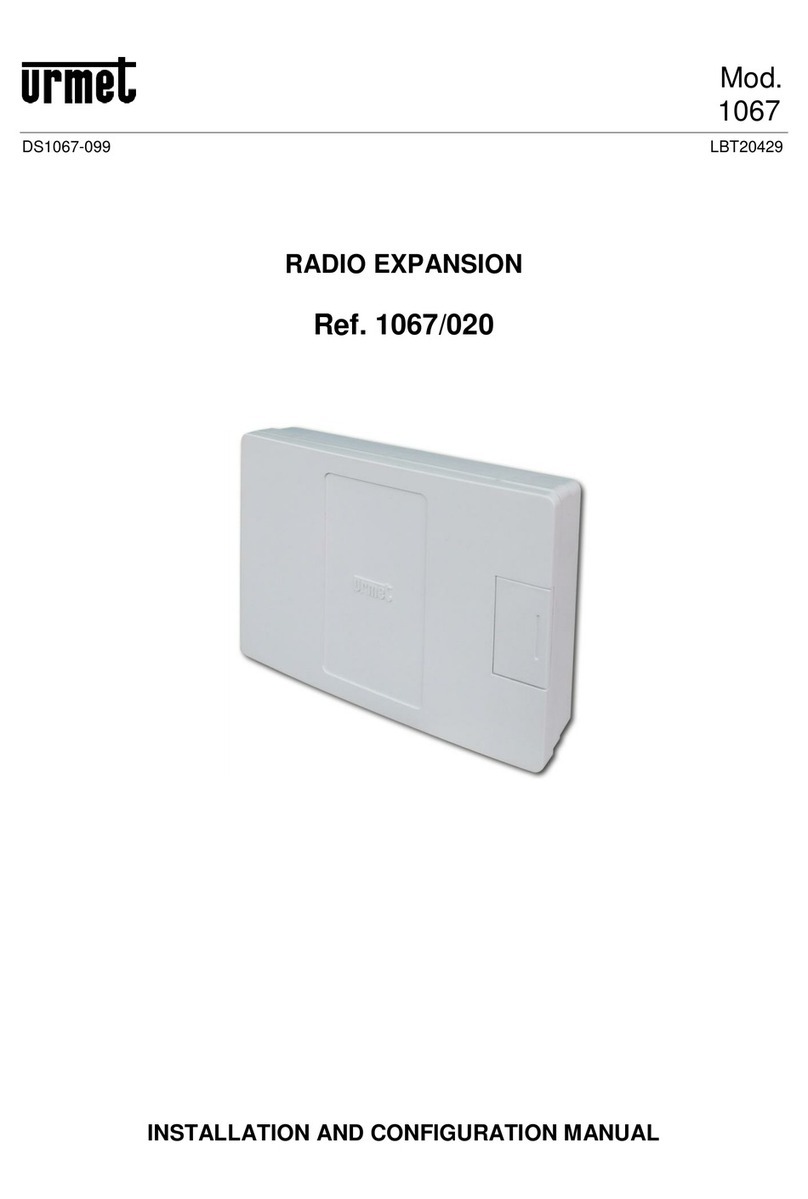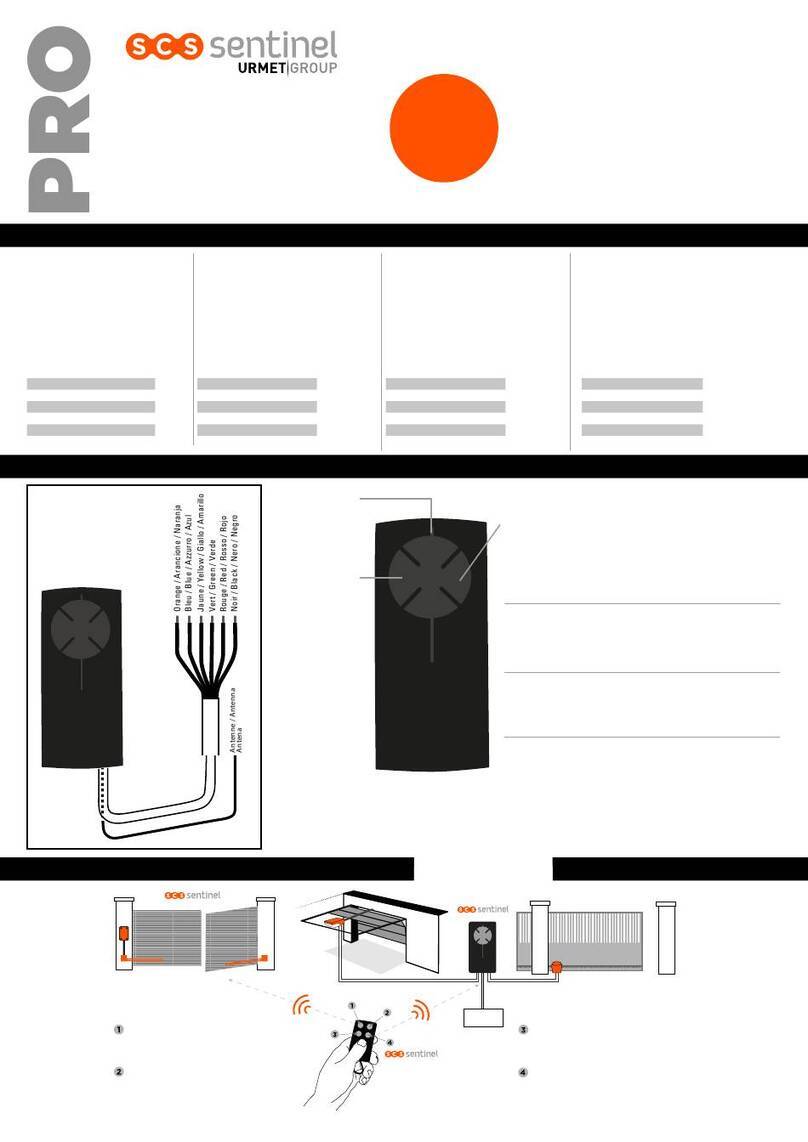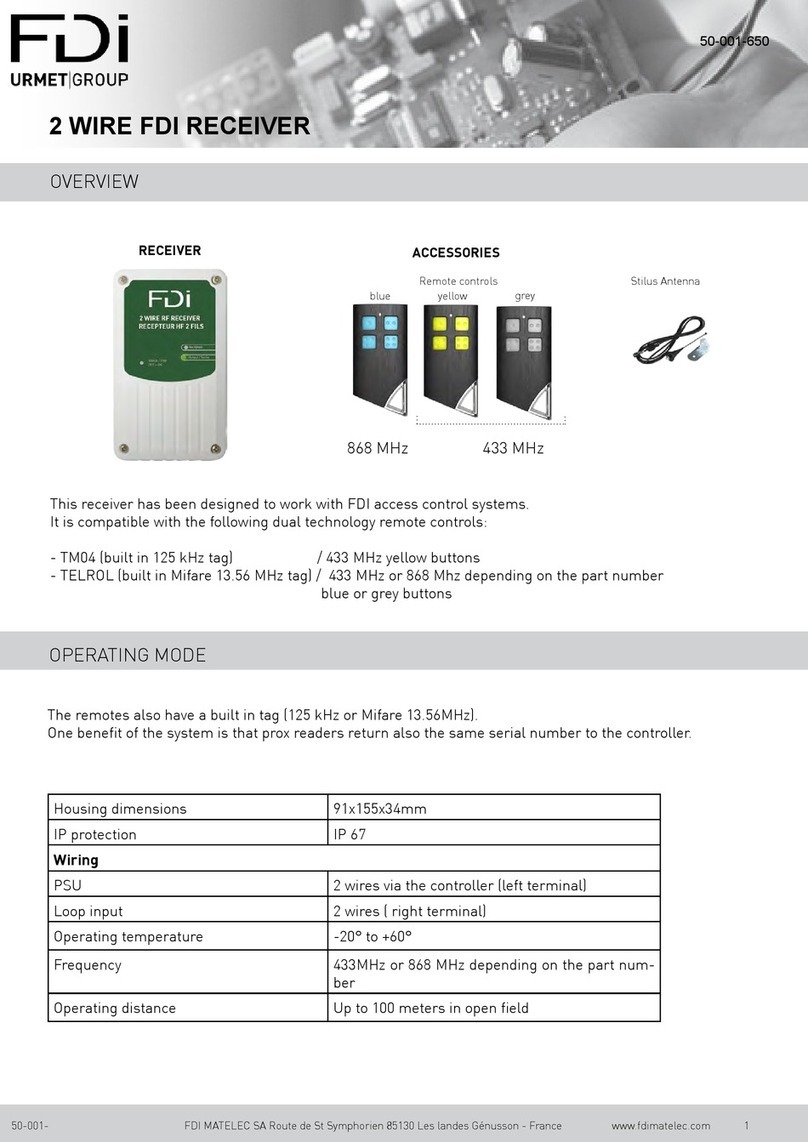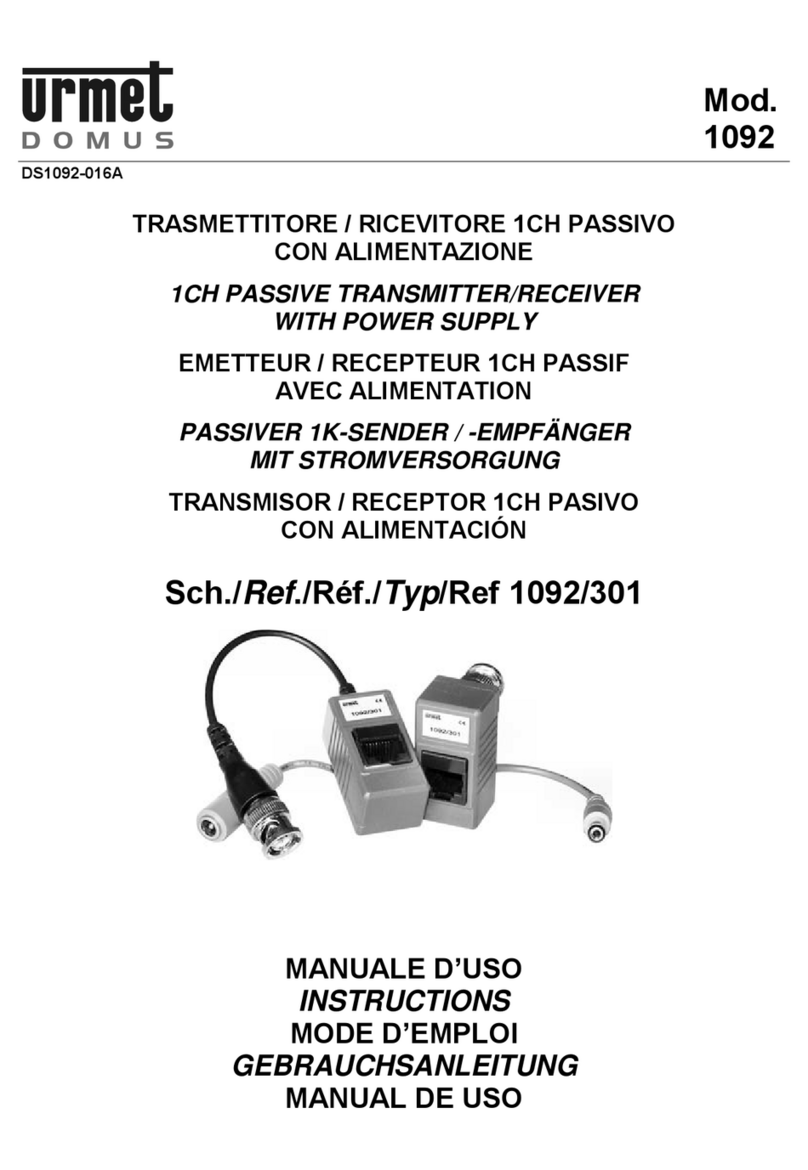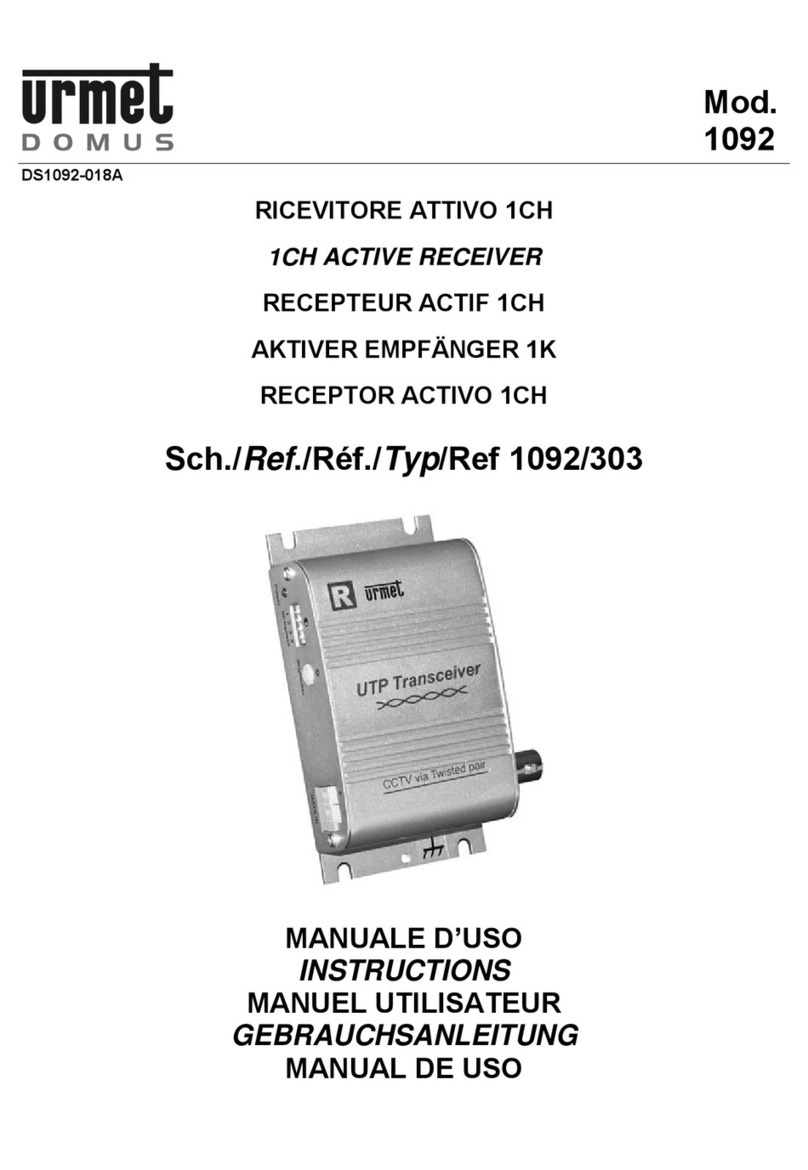
DS1088-003 6
Ogni controller/ricevitore ha un numero di serie univoco (visualizzato sul prodotto con l'indicazione Receiver N°..........).
Quando si crea un nuovo sito di edifici, appartamenti e porte tramite la piattaforma www.easydoorcontroller.com,
inserire il numero di serie visualizzato sul controller, per associarlo alle chiavi/radiocomandi autorizzati a gestire i varchi
da aprire.
Attraverso l'operazione di codifica, i numeri di serie dei controller vengono iscritti nei telecomandi, permettendo la ges-
tione da remoto degli accessi, senza doversi connettere ad essi fisicamente. Successivamente, in caso di smarrimento
di una chiave o di un telecomando, sarà sufficiente ricodificarlo on line. Al primo utilizzo, la nuova chiave o telecomando
annullerà quello smarrito.
ESEMPIO: SMARRIMENTO DI UNA CHIAVE (solo con 1088/12) O DI UN RADIOCOMANDO (sia con 1088/12 che
con 1088/2)
Passo 1: innanzitutto annullare la chiave (o il radiocomando) sul portale.
Passo 2: creare una nuova chiave (o radiocomando), codificarla e farla pervenire all'utente finale.
Passo 3: quando l'utente premerà un qualsiasi pulsante del suo radiocomando, l'ultimo radiocomando verrà annullato e
non sarà più autorizzato all'accesso. Nel contempo, tutte le autorizzazioni del nuovo radiocomando verranno trasferite
al controller. Ogni nuova chiave (o radiocomando) contiene sempre le ultime modifiche del database, i controller sono
automaticamente aggiornati quando queste chiavi (o radiocomandi) vengono presentate al lettore.
Questa modalità avanzata consente, ad esempio, di gestire i siti da un ufficio senza collegamento con i controller.
Una volta ricodificata e utilizzata per la prima volta dall'utente, la nuova chiave sostituirà automaticamente quella vec-
chia. Sul portale www.easydoorcontroller.com sono disponili anche altre funzioni di gestione. Esso è sempre aggior-
nato all'ultima versione e il backup dei dati è integrato.
FUNZIONAMENTO
Quando il ricevitore è nuovo, è in attesa dei radiocomandi di configurazione (uno per porta).
Dalla finestra Door del software Web, è necessario creare un radiocomando di configurazione per canale. Quindi,
presso il sito, premere il primo pulsante dei radiocomandi.
Il ricevitore emette un bip lungo e un bip breve per il canale 1 oppure un bip lungo e due bip brevi per il canale 2.
PRIMO AVVIO
Il ricevitore è in grado di registrare gli ultimi 20.000 eventi degli ultimi 30 giorni.
Dalla finestra Door del software, deve essere codificata una chiave eventi. È possibile selezionare una data di inizio e
una data di fine oppure selezionare solo alcuni tipi di eventi.
Il ricevitore è fornito con l'ora e la data italiane. Se queste impostazioni devono essere modificate (ad esempio, per
gestire eventi), il software Web permette di generare un radiocomando di impostazione del clock.
Questo radiocomando invia al ricevitore l'ora e la data che il software vi ha scritto. In tal modo, se si prevede di impos-
tare il ricevitore alle ore 16.00, occorrerà immettere l'ora nel software quando si codifica questo radiocomando.
ORA E DATA
Ogni volta che un nuovo radiocomando è utilizzato con il ricevitore, la memoria di quest'ultimo viene aggiornata. È tutta-
via possibile creare alcune chiavi di aggiornamento (solo per 1088/12). Da notare che questa funzione è possibile solo
con le chiavi Mifare, non con i radiocomandi. Ciò significa che un lettore di prossimità deve essere collegato al canale
1 del ricevitore almeno per l'aggiornamento.
Non è possibile aggiornare solo una delle due porte. Entrambe le porte dello stesso ricevitore devono essere aggiornate
con la stessa ora e data.
Quando si presenta l'ultima chiave di aggiornamento della prima porta, l'operatore dispone di 1 minuto per presentare
la prima chiave di aggiornamento della seconda porta. Se nessuna chiave viene presentata durante questo lasso di
tempo, il ricevitore emette un bip e l'aggiornamento si conclude.
AGGIORNAMENTO COMPLETO
SCARICARE GLI EVENTI (SOLO PER 1088/12)
N.B.: affinché le chiavi eventi possano essere presentate, occorre collegare un lettore a 2 fili al canale 1 del ricevitore.
Una normale chiave Mifare possiede una memoria sufficiente per 40 eventi. Una chiave 4K Mifare rif. 1088/40 gestisce
200 eventi.
In questa modalità, l'unità di controllo gestisce fino a un massimo di 5.000 radiocomandi. Si tratta della somma dei radio-
comandi autorizzati/non autorizzati. Quando si elimina una porta o un cancello del profilo di accesso della chiave o del
radiocomando, la chiave rimane nella black list del controller.
Fino a 20.000 eventi degli ultimi 30 giorni sono registrati nelle unità di controllo (solo per 1088/12). Questi eventi offline
possono essere trasferiti al computer tramite chiavi speciali.
La gestione chiavi funziona con una tecnologia di lettura/scrittura. Le chiavi sono programmate in remoto tramite un
software Web e un encoder. Successivamente, quando le chiavi sono presentate al lettore, i dati vengono trasferiti
nell'unità di controllo.
Si ricorda che nella modalità remota, tramite il portale www.easydoorcontroller.com, è possibile gestire più funzioni per
ogni sito, impostare i controller e scaricare gli eventi (quest'ultima funzione solo con 1088/12).
MODALITÀ VIRTUAL NETWORK
